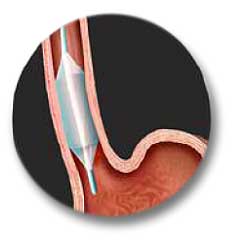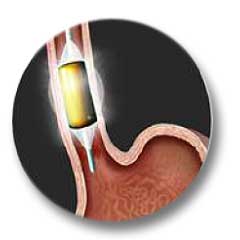Radiofrequency Ablation
For information on Esophageal Cancer Action Network
PHYSICIAN’S REVIEW ARTICLES
Barrett’s Treatment modalities
HALO360
- The HALO360 Ablation Catheter also has a balloon at the tip, but this balloon is covered by a band of radiofrequency electrodes.
- Once the electrodes of the balloon are positioned on the desired treatment area the balloon is inflated. The HALO360 Energy Generator and the ablation catheter then work together to deliver a short burst of energy that is circumferential: 360 degrees.
- The design of this technology limits the energy delivery to a depth clinically proven to remove the diseased tissue while reducing the risk of injury to the deeper healthy tissue layers
- The HALO360+ Ablation Catheter ablates a 3 cm circumferential segment of Barrett’s tissue within the esophagus
- For patients with Barrett’s esophagus lesions longer than 3 cm, the HALO360+ Ablation Catheter is simply repositioned and the ablation steps are repeated.
DURING THE PROCEDURE
Using standard endoscopy techniques, the physician activates and controls the different functions of the HALO360 System.
SIZING

- A catheter is inserted into the esophagus along side the endoscope.
- At the tip of the catheter there is a small balloon that is inflated once inside your esophagus near the treatment area. The balloon and the HALO360 Energy Generator together measure the diameter of your esophagus. This information is used by the physician to select the appropriate treatment catheter.
- The sizing balloon is then removed
ABLATION

HALO90
The HALO90 focal ablation device is designed to treat small areas of Barrett’s esophagus, independently or in conjunction with the HALO360 System.
Using standard endoscopy techniques, the physician activates and controls the different functions of the HALO90 System.
- The ablation catheter is first mounted onto the endoscope.
- Both devices are introduced into the esophagus.
- By manipulating the endoscope, the ablation catheter is positioned within the esophagus at the affected portion of the esophagus.
- The physician delivers ablative energy to the targeted tissue. The energy application is less than 1 second and is delivered in an automated manner. The design of this technology limits the energy delivery to a depth clinically shown to remove the diseased tissue (less than 1 mm) while reducing the risk of injury to the deeper tissue layers.
- For patients with more than one lesion of Barrett’s esophagus, the HALO90 Ablation Catheter is repositioned and the ablation steps are repeated.

